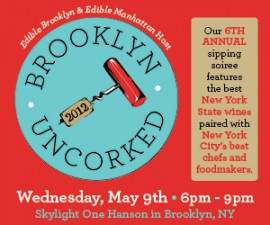No Wine in New York Grocery Stores — Now What?
According to Crain's, the proposal that would have allowed grocery stores, gas stations and anywhere else that sells beer to begin selling wine is dead in the water.
I don't think that this is a shocking development when you consider the power of lobby groups in Albany. Most everyone in the New York wine world has seen how active the Last Store on Main Street group has been. I've been getting near-daily press releases from them for weeks. But as fellow blogger (and frequent LENNDEVOURS commenter) Thomas Pellechia wrote on his blog earlier today, it may have been the New York beer lobby that ultimately wielded the most power in this situation. We may never know for sure.
In the end, regardless of why, the status quo prevailed. The winners are obvious: the wine shops of New York will continue without the stiff competition grocery stores would have posed. The fact is, the good wine shops were going to be fine and contiue to be good. The wine shops that peddle plonk will continue to sell those junk wines. They can continue to be lazy — but at least they'll also be able to keep their businesses alive to support their families. If Thomas is right, the beer distributors are winners too.
And the losers? Yes, consumers lost out on this one, but I'm not worried about them too much. Wine lovers will find wine. And people interested in interesting wines, will find them. They do today.
But what happens to the wineries/winery owners and winemakers who bet big on the grocery store proposal? Fox Run Vineyards' owner Scott Osborn and Red New Winery's Dave Whiting were among the most vocal supporters of the proposal and, whether the boycott of their wines on the part of wine shops was formal or official, it has happened.
It remains to be seen if those wine shop bridges are burned permanently (I doubt it in the long term) but wineries like Fox Run and Red Newt, that were really just looking for another place to sell their wines, are now faced with the prospect of moving forward with even fewer outlets.These weren't the only wineries in favor of the proposal. Some were just much less vocal publicly.
I'm guessing that some wineries are going to have to change their businesses a bit to deal with the loss of wine shops. They'll have to build out their wine clubs, make hard pushes into restaurants and do whatever they can to move more wine in their tasting rooms.
Of course, it's important to remember that this is just one battle. This issue isn't going away. Not by a long shot.














Thanks, Lenn, for your insightful comments.
I continue to believe selling wine in grocery stores, alongside food with which it pairs so well, is the best way to introduce new consumers to the appreciation of healthy, responsible consumption of wine with their meals. In failing to pass this measure, we may have missed our opportunity to greatly increase the number of New Yorkers who enjoy wine in this way on a regular basis and have hence restricted our opportunity to grow as an industry.
I agree that there are many great wine shops in the state that provide excellent selection and service to their customers. Many of these shops sell our wines. Over the past few days I have received many emails from wine shops who suggest that grocery stores will only carry cheap, low quality wines and will be unable to provide knowledgeable wine service. Then, in nearly the same breath, I hear the cry that the very grocery stores that fail to provide the great selection and service that wine drinkers have come to expect from their local wine shops, are going to take away their customers. This is a perspective on marketing that I don’t understand.
Even if the grocery store wine selection and service is abysmal as I am lead to believe by some, the grocery store setting will provide a level of convenience that will introduce new customers to the enjoyment of wine. The wine shops will have a competitive advantage to retain their current customers as well as the opportunity to engage a growing customer base.
My view on this issue in not borne of a selfish desire to grow my business at the expense of others’. It comes from my desire to grow and expand the wine industry of New York State; from growers, to wineries, to wholesalers, to stores (liquor stores AND grocery stores), to the consumer.
The loser that we must not forget is the grower. The grape industry in the New York is facing the most catastrophic downturn since the 1970′s. Without a substantial increase in customer base and sales, I will be forced to make drastic cuts to growers who I have worked closely with for the past ten years. But it’s not just me. And it’s not just the boutique, family wineries that we need to think about. Many thousands of tons of grapes are likely to drop in the vineyards this fall. These are the grapes that would have gone to some of the very large wineries in New York and into the mainstream wines that likely would have been common on most grocery store shelves. These wines don’t come from huge, corporate wineries. They come from farms. They come from families who have worked for decades and generations to build the agricultural communities that make up the grape growing regions of New York State.
When I speak about this issue, I’m not just talking about a bottle wine and who gets the buck for selling it. I speak the voice of our farms, and our families. And I hope for the day when we can work as an industry to grow and flourish together.
David Whiting - winemaker/co-owner
Red Newt Cellars Winery and Bistro
Where was Uncork NY to help this bill…are they now irrelevant ? Do they need to be cut off with funds ? Do they play up to a very few select old school buddy system wine producers, could that have been the problem ?
Time for a change !!!
Lets Uncork NY the right way right now, as they are corked !!! Time for a change…!!!
David,
Well said, and you touch on a subject that is important when you mention the seeming paradox of small stores saying the grocers would carry plonk and that would not help small wineries, and then they say that the grocers will wipe them out.
The obvious point there: in New York State, most liquor stores carry an inventory that is much higher in plonk than in the small winery production. Their cry is called ‘wanting it both ways.’
Had I still owned a shop I would have been praying for the retailer association to fight for beer and groceries in wine shops and then I would have set out to build a better business that the grocers could provide-but that would be work!
John,
You know my feeling about the Foundation. But the one thing that organization can’t be is political, at least not obviously political. It would cease to have any impact if it got involved in political arguments.
Thanks to Lenndevours for providing a forum for NY wineries to exchange viewpoints and learn from one another. One would have thought that this task belongs to the NY Wine and Grape Foundation.
Another, and perhaps the biggest looser, is the state of NY. This bill was all about raising taxes and was so flawed that it had no chance to pass in its original shape. Other states have successfully increased wine distribution, without threatening the existence of wine stores, as this one sided proposal did. Those who wish to try again should include in their efforts a broad constituency so that there are enough quid pro quos to garner greater support.
As to the prospect of the NY Wine Industry, I think they are excellent, as the quality of NY wines has never been as good as it is now. However the sad part is that to translate that into sales, the industry has been notoriously lacking in leadership. The NY W & G F is grossly underfunded and under the best circumstances has done a passable job on our behalf. What is needed is a strong NY Wine campaign and representation to raise much higher the image of NY wines in the eye of the consumer. Every other successful wine region, state or country has done so but NY is fragmented, inefficient and through its mediocre efforts is hurting its own image.
Against that background, making the distribution channel the issue misses the point. If NY wines can’t sell in stores they won’t in the gas station or the supermarket. To change this picture NY Wine must work on its image aggressively. That takes funds and leadership. Both of which are lacking presently.
Charles,
My understanding is that the governor went to the retailer’s association before releasing his proposal and offered them a chance to ask for what they wanted in order to support the proposal. Their response was to tell the governor to get lost.
Why his advisers did not recommend that he come up with concessions built into his proposal is beyond comprehension. Some believe that the governor was lead to slaughter on the issue by insiders.
As for the funding of the Foundation, it was set up 1985 to be funded with reduced state money over five years, with the industry increasing its funding over those 5 years and then taking over full funding of the Foundation. The industry never stepped up to its responsibility-and once govt funding is set in place, it’s almost impossible to stop the process until a major economic crunch forces the issue-and here we are. The wine industry is at fault here.
Soon we’ll probably be hearing that the reason some wineries are having financial difficulty is because of cuts to Foundation funding-at that will be nonsense.
oops, make that led to slaughter…
Thomas,
You are correct in your assessment of the Foundation and its’ initial design to become self-funded. However, over the past decade, there have been ample opportunities for the Foundation to accept various proposals - including market orders involving additional excise taxes - to self-generate funding. These proposals never saw the light of day due to the reluctance of some major players to accept higher tax rates. I believe it’s unfair to lay all the blame on the wine industry at large when it was never approached, or perhaps even aware. Perhaps this will open up discussions…
Rich and Thomas,
Back when the governor announced he was defunding the Foundation, I made a suggestion that this presented an opportunity for reform. Since we cannot change the past, what should we do about the future?
Let us look at a few examples.
Not too long ago, you could not give away German Wines. Not too long ago NY was ahead of Washington. Not too long ago the wines of Chile were barely known to exist. Not too long ago there were no vineyards in Santa Barbara County.
All the aforementioned comparables make today great wines and they aggressively promoted them, building a strong positive image in the consumer’s mind.
NY wines are now of a high quality. But we are not telling our story. We think for some reason that it is enough to make good wine and the world will beat a path to our door.
It is up to us really to step up to the challenge and learn from the successes of the above state, region and countries. By the way our own Bruce Schneider is partly responsible for building the image of Chile and Germany. Why not put a budget together for a similar campaign? It will take leadership and I hope someone will rise to the occasion to build a coalition to work on this important agenda.
Charles, Rich,
Walter S. Taylor and I talked when the Foundation was getting started. He chose not to have Bully Hill be part of it. I asked him why. His response was prescient: he said that if the industry allows it to go forward, the industry will become addicted to state money and-worse-it will get an ineffective government run organization.
Charles, you are right, the industry must look forward. But how are you going to make that happen? If the NY wine industry has been content for 25 years to allow the government funded promotion arm to fritter, what is going to motivate the industry to take the reins?
Can the industry come up with $2 million annually? Actually, based on what that amount of funding has produced-the industry can probably get more done with half…
All I know is if I didnt have real vineyards and wineries in driving distance of my house, I would not be able to drink propper wine. Id probably have to drive to Wine Library in Jersy. None of the local wine stores in my area have anything even remotely appelation specific, its all “Product of Italy” or “Product of France” nothing specific. And their is no way that Hannafords is gonna do better. (Although in Europe, the supermarket selection is not bad, better than my local winesshop).
Rowland,
Your post helps shoot down the argument of liquor stores that claim NY wineries would lose out if wine were sold in grocery stores. Those are the same liquor stores uninterested in selling NY wine.
How can NY wine lose out on what it doesn’t have?
Wholesalers in NY having to deal with large grocery chains would lose their grip on the control that they now have over small retail outlets, which is why your selection of wine sucks. Grocery stores would think for themselves and stock those items that bring in a profit to them, not just to the wholesalers.
It’s amazing how many liquor stores have no clue about the damage to their potential profit that buying on a wholesaler’s “deal” can actually do to them-especially when they invest in stacks of cheap spirits and plonk wine. Many small business people make the common mistake of viewing cash flow as profit.
Thomas,
While $2 million sounds like a lot of money, (about $10,000 per NY winery), most of them are already paying close to half that amount in membership to wine trails and the Foundation.
If, without a penny more, these sums are routed instead in their totality to a serious PR firm, that is already $1 million and you can get a lot more done with that than the trickle of today. To raise 2 million or even more becomes an exercise in convincing the wineries that this is a good investment.
As an example, if, operating at break even point and after three years of a successful marketing campaign, a winery can raise its bottle price by $1, this is pure profit. A winery that produces 100,000 bottles will reap an extra $100k in profit. After deducting its contribution of $10K per year, it is still ahead by $70K. You can do your own permutation as well. But it is easy to see that most NY wineries stand to benefit from a successful PR campaign that is waged at that level. Today between the trails and the Foundation much of the budget goes instead to salaries. Mind you I am not preaching to lay off well meaning people, only showing that the money does exist.
Charles,
I agree. I suppose that after 25 years in and connected to the NY wine biz, and seeing the Foundation from its inception, I’ve been disappointed so many times that I’ve lost a little bit of the old fervor I once had.
Maybe you need to get crackin’ and organize the wine industry’s PR effort. Just make sure you keep China and Europe off your travel agenda until after you succeed with PR in the U.S. Just to keep things in perspective…
What a sad news is that! “No Wine in New York Grocery Stores” Anyway, I agree with you there that “Wine lovers will find wine. And people interested in interesting wines, will find them.” I just wish people will get not angry with this. Thanks for sharing this post.
-krisha-